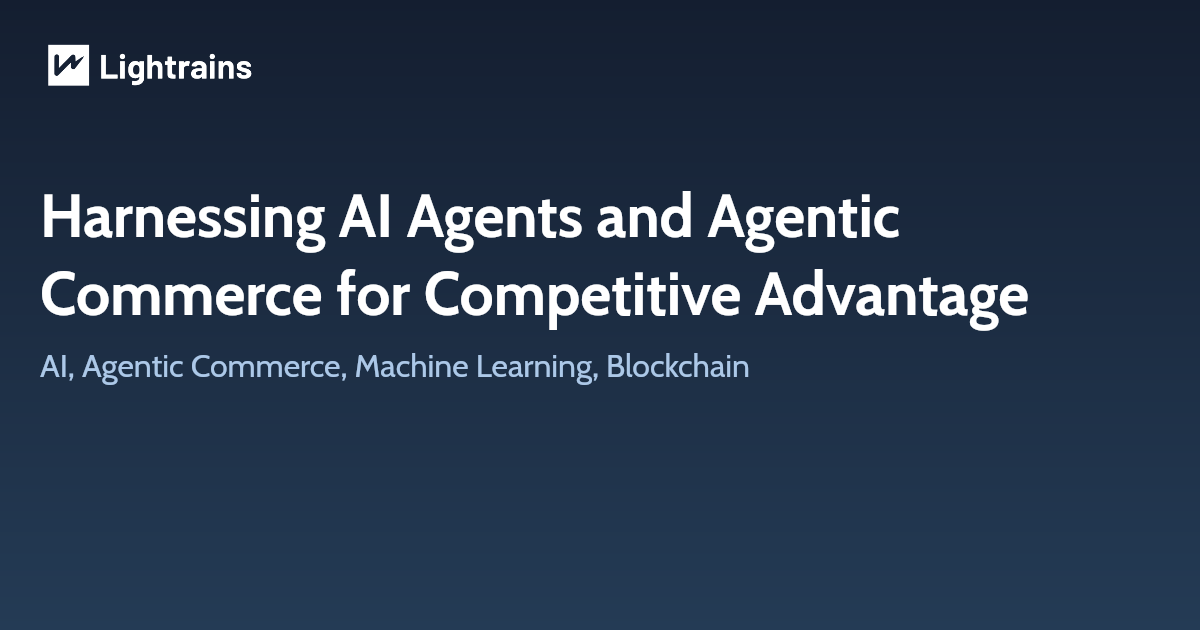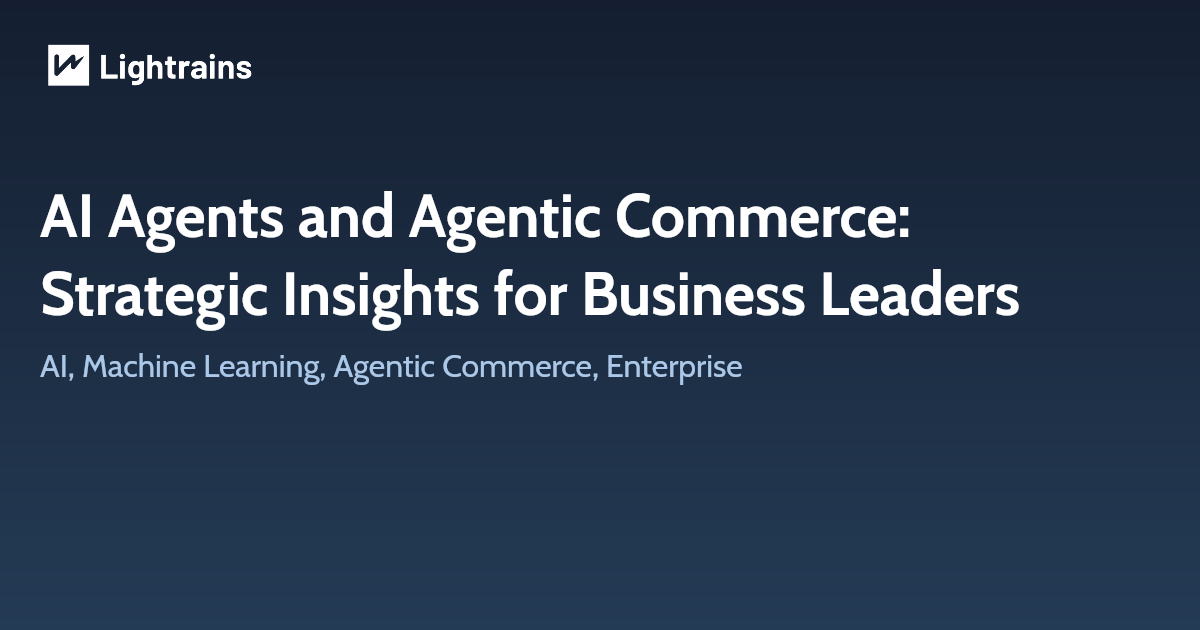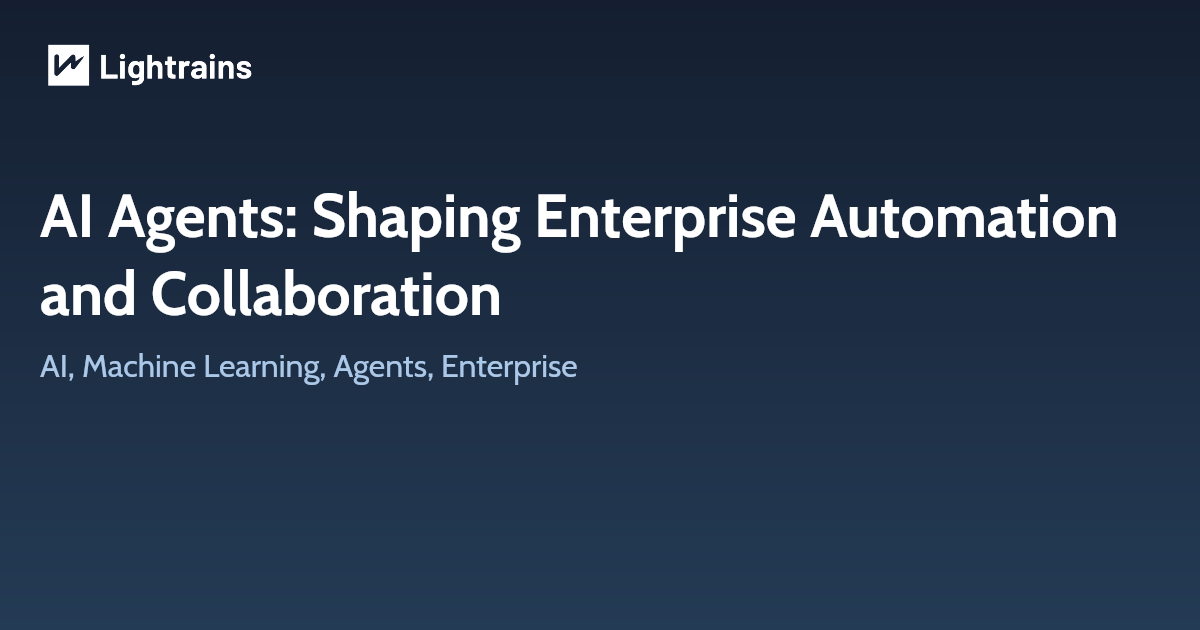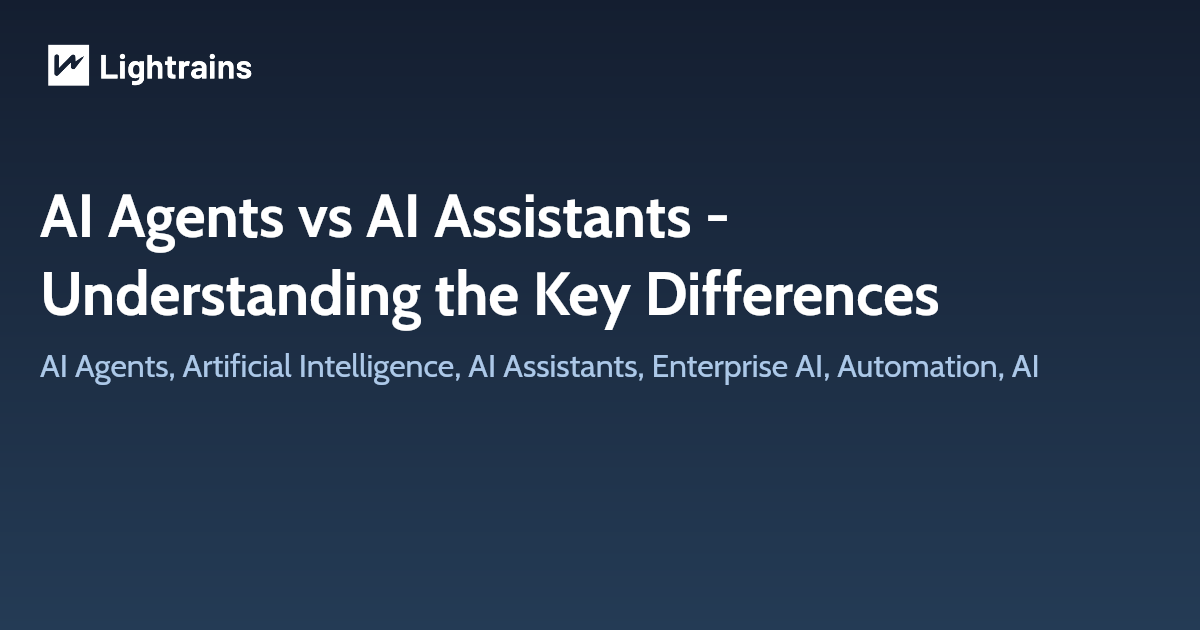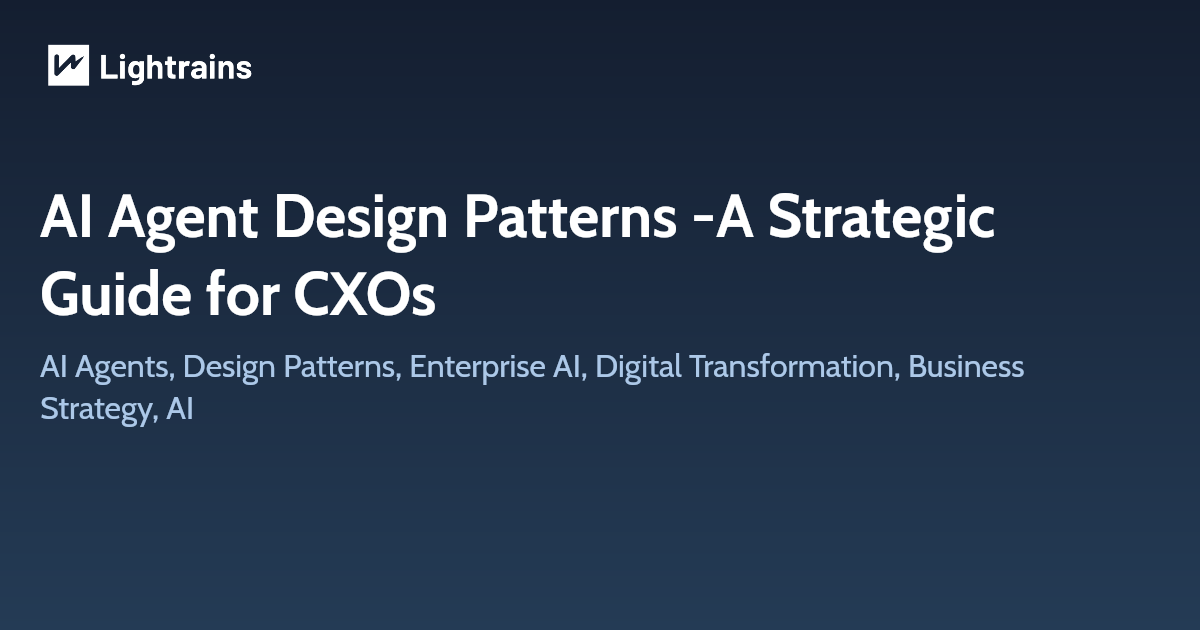
In today’s hyper-competitive business landscape, staying ahead requires more than just efficiency—it demands innovation, agility, and the ability to leverage cutting-edge technologies. For CXOs, AI-powered agents represent a game-changing opportunity to redefine customer experiences, optimize operations, and unlock new revenue streams. However, the true potential of AI lies not just in its capabilities but in how it’s designed and deployed.
This guide dives deep into AI Agent Design Patterns—strategic frameworks that enable AI systems built on Large Language Models (LLMs) to operate intelligently, autonomously, and collaboratively. By understanding and implementing these patterns, CXOs can transform their organizations into AI-driven powerhouses.
Why AI Agent Design Patterns Matter for CXOs
AI agents powered by Large Language Models (LLMs) are no longer just tools for automation they are strategic assets that can:
- Enhance Customer Engagement: Deliver personalized, real-time responses to customer inquiries.
- Streamline Operations: Automate complex workflows and decision-making processes.
- Drive Innovation: Enable cross-functional collaboration and ideation at scale.
- Improve Decision-Making: Provide data-driven insights and recommendations.
To achieve these outcomes, CXOs must adopt a structured approach to AI agent design. Below, we explore four key design patterns — Reflection, Tool Use, Planning, and Multi-Agent Collaboration—and their transformative use cases for businesses.
1. Reflection Pattern: Continuous Improvement for Unmatched Accuracy
The Reflection Pattern equips AI agents with the ability to self-evaluate and refine their outputs. This iterative process ensures that the agent’s performance improves over time, delivering increasingly accurate and relevant results. This pattern builds on fundamental LLM concepts like fine-tuning and prompt engineering.
Technical Implementation:
Feedback Loops: The agent analyzes its outputs against predefined metrics (e.g., accuracy, prompt, relevance) and iterates to optimize performance. Reinforcement Learning: The agent learns from past interactions and adapts its behavior to align with business goals.
Strategic Use Cases for CXOs:
Customer Support: AI agents can review customer interactions, identify gaps in responses, and refine their communication to improve satisfaction scores (e.g., CSAT, NPS). Content Creation: For marketing teams, AI agents can draft content, evaluate its alignment with brand guidelines, and iteratively enhance its quality before publication. Risk Management: In financial services, AI agents can analyze transaction patterns, identify anomalies, and refine detection algorithms to reduce fraud.
Business Impact:
Enhanced Customer Trust: Consistently accurate and polished interactions build customer confidence. Operational Efficiency: Reduced need for human intervention in quality control processes.
2. Tool Use Pattern: Empowering AI with Advanced Capabilities
The Tool Use Pattern integrates external tools and APIs into AI agents, enabling them to perform tasks beyond their native capabilities. This pattern transforms AI agents into versatile problem-solvers.
Technical Implementation:
API Integration: Connect AI agents to databases, CRM systems, or analytics platforms. Function Calling: Enable agents to execute code, perform web searches, or interact with IoT devices.
Strategic Use Cases for CXOs:
Real-Time Data Analysis: Equip AI agents with access to live data feeds to provide real-time insights for decision-making (e.g., stock market trends, supply chain disruptions). Personalized Marketing: Use AI agents to pull customer data from CRMs and generate hyper-personalized campaigns. IT Operations: Automate incident resolution by enabling AI agents to execute scripts, restart servers, or escalate issues to human teams.
Business Impact:
Faster Decision-Making: Real-time access to data and tools accelerates response times. Scalability: AI agents can handle a wider range of tasks without requiring additional human resources.
3. Planning Pattern: Tackling Complexity with Structured Execution
The Planning Pattern enables AI agents to break down complex tasks into actionable steps, ensuring systematic and efficient execution.
Technical Implementation:
Task Decomposition: The agent divides a high-level goal into sub-tasks (e.g., research, analysis, drafting). Workflow Automation: The agent executes each step sequentially or in parallel, depending on dependencies.
Strategic Use Cases for CXOs:
Project Management: AI agents can create project plans, assign tasks, and track progress, ensuring timely delivery of initiatives. Sales Enablement: For complex sales cycles, AI agents can develop tailored outreach strategies, including lead research, proposal drafting, and follow-up scheduling. Product Development: AI agents can outline product roadmaps, conduct market research, and generate feature requirements based on customer feedback.
Business Impact:
Improved Efficiency: Structured workflows reduce errors and delays. Strategic Alignment: Ensures that all tasks align with overarching business objectives.
4. Multi-Agent Collaboration Pattern: Harnessing the Power of Teamwork
The Multi-Agent Collaboration Pattern involves multiple AI agents working together, each specializing in a specific domain. This pattern mimics human teamwork, enabling the agents to tackle complex challenges collaboratively.
Technical Implementation:
Role Assignment: Each agent is assigned a specific role (e.g., data analyst, content creator, strategist). Communication Protocols: Agents share information, debate ideas, and reach consensus using predefined rules.
Strategic Use Cases for CXOs:
Strategic Planning: Multiple agents can collaborate to develop business strategies, with one analyzing market trends, another evaluating financial data, and a third drafting the final plan. Customer Journey Optimization: Agents can work together to map the customer journey, identify pain points, and propose solutions. R&D Innovation: In product development, agents can brainstorm ideas, simulate outcomes, and refine concepts collaboratively.
Business Impact:
Holistic Solutions: Combines diverse expertise to deliver comprehensive results. Innovation at Scale: Encourages creative problem-solving and ideation.
AI Agent Design Patterns Chart
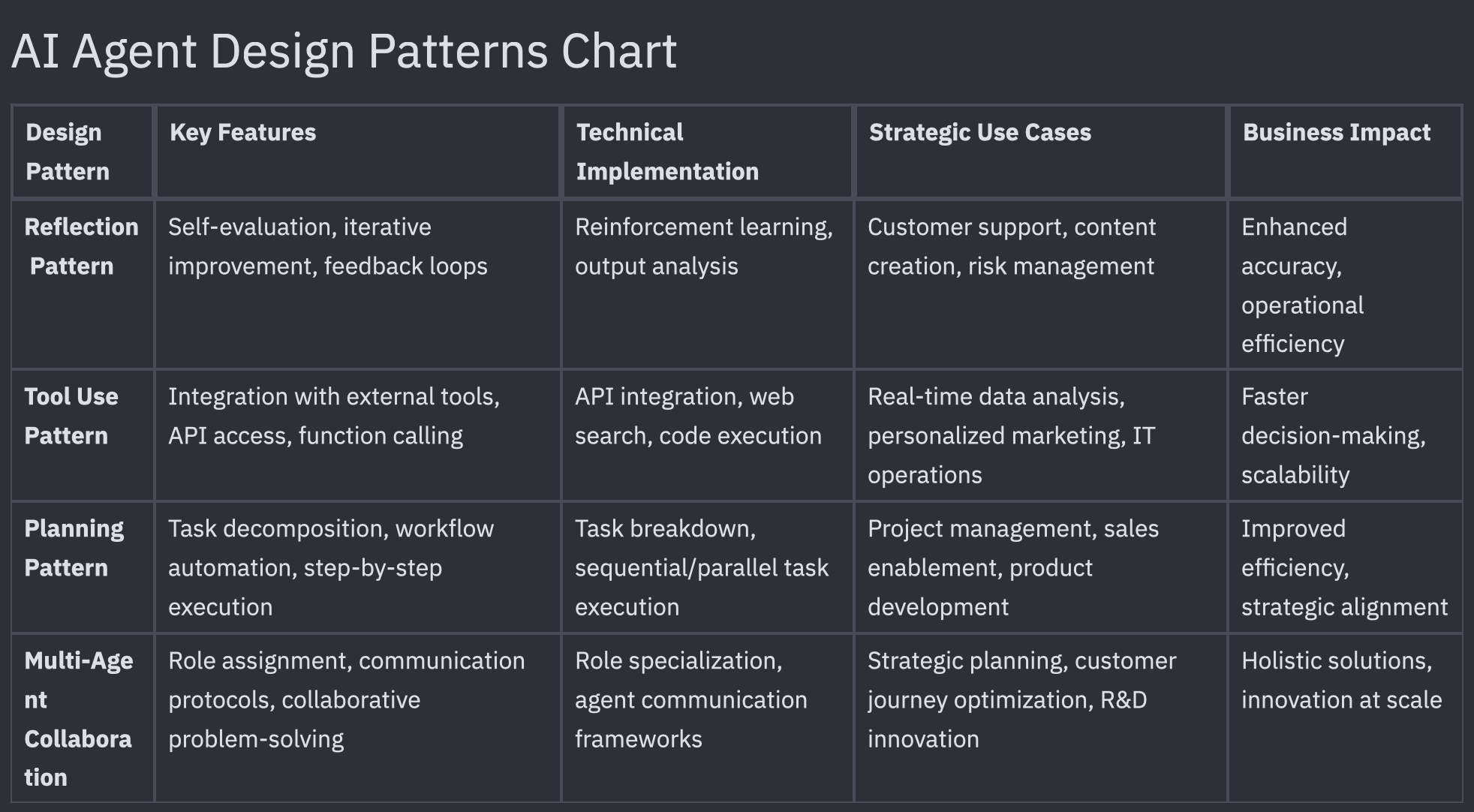
How CXOs Can Implement AI Agent Design Patterns
To leverage these design patterns effectively, CXOs should follow a structured implementation roadmap:
- Assess Business Needs: Identify areas where AI agents can add the most value (e.g., customer support, operations, innovation).
- Choose the Right Patterns: Select design patterns that align with your business goals and use cases.
- Invest in Infrastructure: Ensure your organization has the necessary tools, APIs, and data pipelines to support AI agents.
- Monitor and Optimize: Continuously evaluate agent performance and refine their design to maximize ROI.
The Future of AI-Driven Business Transformation
For CXOs, AI agent design patterns are not just technical frameworks—they are strategic enablers that can drive business transformation. These patterns build upon fundamental LLM technology, extending their capabilities into practical business applications. By adopting these patterns, organizations can:
- Deliver Exceptional Customer Experiences: Through personalized, real-time interactions.
- Achieve Operational Excellence: By automating complex workflows and decision-making processes.
- Foster Innovation: By enabling cross-functional collaboration and ideation.
The question is no longer whether to invest in AI but how to design and deploy it effectively. By embracing AI agent design patterns, CXOs can position their organizations at the forefront of the AI revolution. Whether you’re handling customer inquiries, developing marketing strategies, or solving complex business challenges, these patterns provide a roadmap for success. Embrace them, and watch your business thrive in the age of AI.
Ready to take your business to the next level? Start integrating these AI agent design patterns today and see the difference they can make!
This article originally appeared on lightrains.com
Leave a comment
To make a comment, please send an e-mail using the button below. Your e-mail address won't be shared and will be deleted from our records after the comment is published. If you don't want your real name to be credited alongside your comment, please specify the name you would like to use. If you would like your name to link to a specific URL, please share that as well. Thank you.
Comment via email